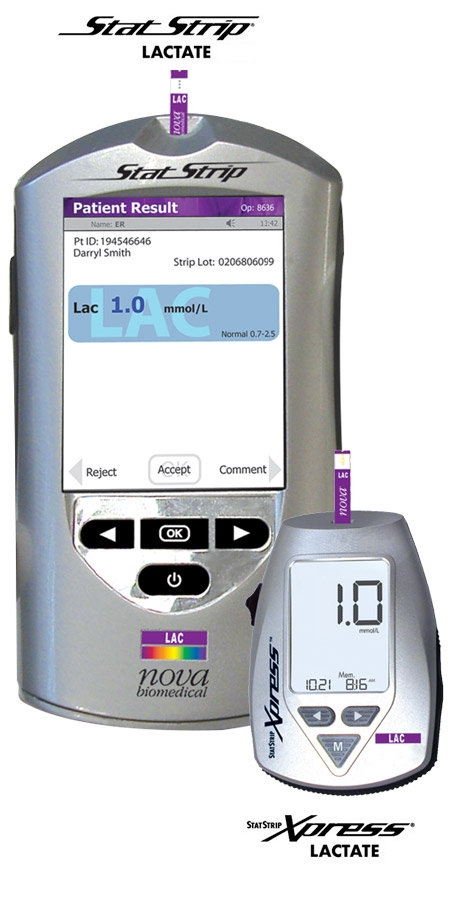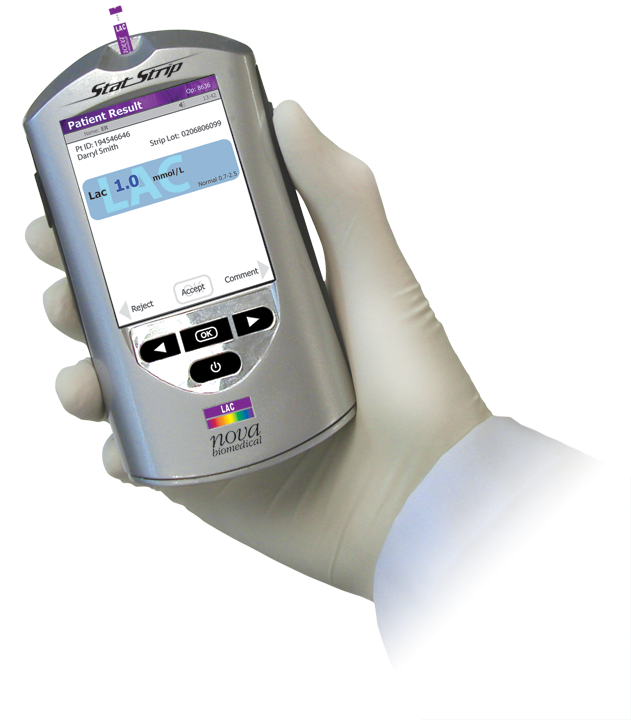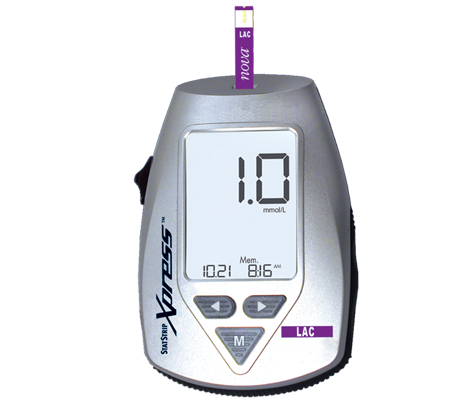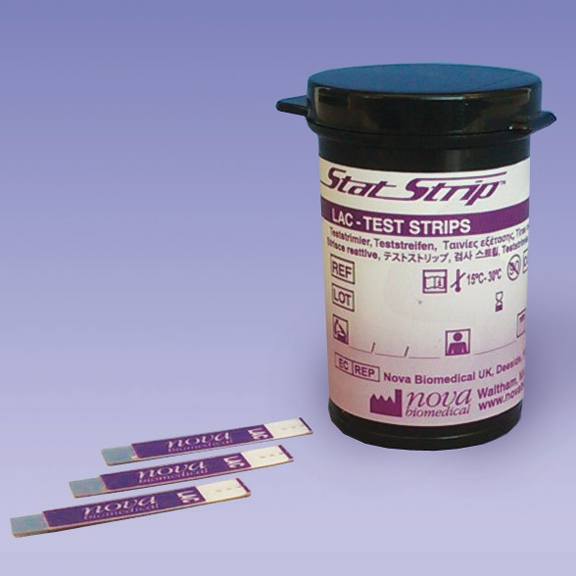 StatStrip® and StatStrip Xpress® Lactate Meters
StatStrip® and StatStrip Xpress® Lactate Meters
Lactate Xpress is not available in the U.S. or Canada
Features:
- Rapid sepsis detection and monitoring
- Fastest turnaround – 13 seconds
- 0.6 μL whole blood sample
- Excellent correlation to central laboratory reference methods
The StatStrip Lactate Hospital Meter System is a handheld point-of-care testing (POCT) system that brings lactate testing directly to the patient’s bedside. Lactate is currently measured on blood gas analyzers, which creates numerous problems for bedside testing. Blood gas analyzers require anaerobic, arterial samples; large sample volumes (100-200 microliters); and require long analysis times (up to 2.5 minutes). In addition, blood gas analyzers are complex to operate, fixed in location, and expensive to purchase and use for serial lactate testing. StatStrip Lactate provides the fastest turnaround time possible (13 seconds), on the smallest whole blood sample (0.6 microliters), and can be easily operated by medical and nursing staff. StatStrip Lactate is a very low cost device that makes lactate testing practical and affordable in any size ED, ICU, or medical unit.
Lactate and sepsis
Global sepsis and sepsis mortality rates are alarming
Worldwide, severe sepsis and septic shock affect 18 million people annually, accounting for 1,400 deaths each day.1 In the U.S., severe sepsis occurs in over 750,000 patients each year1 and accounts for nearly 10% of all ICU admissions.2 An estimated 28% to 50% of all U.S. patients with sepsis die—much higher than the number of deaths from prostate cancer, breast cancer, and AIDS combined.3 In the United Kingdom, the annual sepsis mortality rate is 35%,1 with an estimated 36,800 deaths occurring in intensive care units (ICU).4
Early detection and aggressive treatment of sepsis increases survival chances5
Sepsis is a time-critical condition that requires early recognition and initiation of care. Diagnosis is often delayed because the clinical signs and symptoms of sepsis may present subtly; however, a patient’s condition can deteriorate rapidly—especially patients with septic shock, for whom the rate of survival decreases 7.6% for each hour antimicrobial therapy is delayed.6
“[We] strongly recommend that more rapid TTAT [therapeutic turnaround time] of lactate results be considered as a way to improve outcomes in ED, OR, and ICU patients.” – National Academy of Clinical Biochemistry7
New Surviving Sepsis Campaign (SCC) guidelines call for rapid lactate results
SSC now recommends early screening and protocolized goal-directed therapy for sepsis patients with lactate levels great than 4 mmol/L, targeting treatment to normalize lactate.8
This recommendation is endorsed by the Society for Critical Care Medicine, European Society of Intensive Care Medicine, Intensive Care Society, College of Emergency Medicine, and National Academy of Clinical Biochemistry, among others.4
Real-time, POC lactate testing allows for:
- Early sepsis detection
- Rapid initiation of lactate goal-directed protocols for sepsis care
- Monitoring of resuscitation therapies
- Prognosis indication for patient outcomes9
01928 704040 | uk-info@novabio.com
References
- Perman, S. et al. (2012). Initial emergency department diagnosis and management of adult patients with severe sepsis and septic shock. Scand J Trauma Resusc Emerg Med, 20, 41. doi:10.1186/1757-7241-20-41
- Nachimuthu, S. et al. (2012). Early detection of sepsis in the emergency department using Dynamic Bayesian Networks. AMIA Ann Symp Proc, 2012, 653-62. Retrieved from link
- National Institutes of Health. (2012). Sepsis fact sheet. Retrieved from https://www.nigms.nih.gov/Education/factsheet_sepsis.htm
- Daniels, R. (2011). Surviving the first hours in sepsis: Getting the basics right (an intensivist’s perspective). J Antimicrob Chemother, 66, ii11-23. doi:10.1093/jac/dkq515
- Hall, M. et al. (2011). Inpatient care for septicemia or sepsis: A challenge for patients and hospitals. NCHS Data Brief, 62, 1-8. Retrieved from link
- Kumar, A. et al. (2006). Duration of hypotension before initiation of effective antimicrobial therapy is the critical determinant of survival in human septic shock. Crit Care Med, 34(6), 1589-1596. Retrieved from link
- National Academy of Clinical Biochemistry. (2007). Laboratory medicine practice guidelines: Evidence- based practice for point-of-care testing. Washington, D.C.
- Shirey, T. (2007). POC lactate: A marker for diagnosis, prognosis, and guiding therapy in the critically ill. Point of Care, 6, 192-200. doi:10.1097/poc.0b013e3181271545
- Dellinger, R. et al. (2013). Surviving sepsis campaign: International guidelines for management of severe sepsis and septic shock: 2012. Crit Care Med, 41, 580-637. doi:10.1097/CCM.0b013e31827e83af.
Specifications
StatStrip Lactate Hospital Meter System

Weight: 220 g (0.49 lb)
Size: 147 mm x 79 mm x 30 mm
(5.8 in x 3.1 in x 1.18 in)
Data Storage:
Patient Tests: 1,000 tests
QC Tests: 200 tests
Users: 8,000 users
Connectivity:
Meter Data Output: RJ-45 Ethernet Port
Protocol: TCP/IP Ethernet 100 Mbit
Standard: POCT1-A2 Compliant
Setup Program: NovaNet™ Web-Based Instrument Manager Software
Battery Information:
Type: 3.7V Li Polymer Rechargeable Battery
Features: Rechargeable/Replaceable
Life: 6-8 hours in use (approximately 40 tests w/barcode scans)/12-24 hours standby
Docking Station:
Optional accessory; desk or wall mount charging station with RJ-45 Ethernet jack. 3 LED indicator lights showing connection status, transmit/receive data, and charging status. Extra battery slot included for recharging and storage of spare battery.
Additional Features:
- Color touchscreen
- Built-in barcode scanner
- Traditional QC with target values assigned to QC materials
- Numeric or pass/fail QC
- QC prompting or QC lock out
- Abnormal and critical ranges flagged by color highlighting
- Canned or free text user comments
- Rejecting of results at meter (optional) for repeat testing
- Accepting patient ID or accession number
- Use of operator password (lockout)
- Entry of offline tests
- Entry of ICD-9 Diagnosis codes
- Ordering physicians ID
- Onscreen training mode
- Correlation mode
- Slope and intercept adjustment
- Web-based meter configuration by location
- Custom, web-based meter configuration by location
- Connect to hospital ADT
- Connect to all LIS/EMR
- POCT1-A2 data output
StatStrip Xpress Lactate Meter

Statstrip Xpress Lactate not available in the U.S. and Canada
Designed for applications that do not need data interfacing and connectivity, Xpress Lactate retains all of the analytical performance features of StatStrip Lactate.
Weight: 75 g (0.2 lb)
Size: 91 mm x 58 mm x 23 mm (3.6 in x 2.3 in x 0.9 in)
Data Storage:
Patient & QC Tests: 400 tests total (FIFO)
Connectivity:
Data Transfer: Strip Port Connection to USB
Data Program: Nova Microsoft-Excel based data transfer software
Battery Information:
Type: 3V Li Button Battery
Features: Replaceable
Life: Minimum 600 tests
Additional Features:
- LCD black/white display
- Large numeric display (30 mm)
- Traditional QC with target values assigned to QC materials
- Units of measure based on meter ordered (mg/dl or mmol/L models)
- Automatic shut-off when not in use
- Automatic sample detection and analysis start
- Automatic sample counter with date/time stamp for data tracking
StatStrip Lactate Test Strips

Tests:
Tests Measured: Blood Lactate, Hematocrit Corrected
Test Reported: Lactate
Test Time: 13 Seconds
Test Strip Volume: 0.6 µL
Test Methodology: Electrochemistry
Sample Types & Operating Modes:
Whole Blood: Arterial, Venous
Lactate Measurement Range:
0.3-20.0 mmol/L (3-180 mg/dL)
No Interferences From:
Hematocrit, Ascorbic Acid, Uric Acid, Paracetamol (Acetaminophen), Bilirubin
Operating Ranges:
Temperature: 15°C- 40°C (59°F-104°F)
Altitude: 4,572 m (Up to 15,000 ft)
Humidity: 10% to 90% relative humidity
Hematocrit: 20% – 65%
Reagents and Strips:
Strips: 25 strips per vial; 2 vials per package
QC: Three levels (Low, Normal, High);
sold separately
Linearity: Five levels available
Test Strip & QC Stability:
24 months from date of manufacturing
3 months open-vial stability
Certifications and Compliance: Nova Biomedical is certified to FDA Quality System Regulations and EN ISO 13485:2016 Complies to IVDD Tested according to: EN 61010-1:2010, EN 61010-2-101:2015, EN 60825-1/A1:2014.
CSA Standards. Patented Technology. Patents 6,287,451 / 6,837,976 / EP 1 212 609 / CA 2,375,092 / EP 1497 449 / JP 405 0078
Specifications current as of revision date.